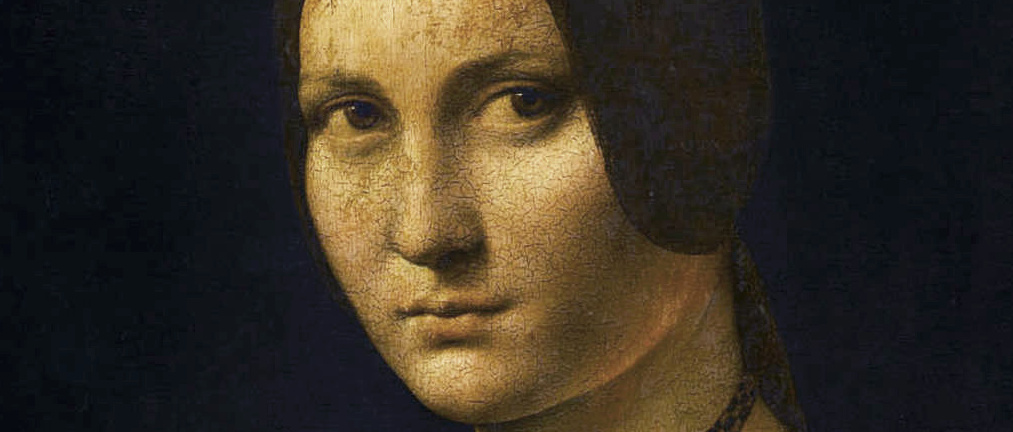by Andrew Carr
People assume a unique posture when they look at art. I was recently sitting on a bench at the Mia, not looking at the collection, but at the other visitors as they perused the room. Sometimes they seemed to be waiting around, trying to pass the time—as if they were reading the schedule on the side of a bus stop. Sometimes they reminded me of men in a clothing store, pretending to browse while their girlfriends try on something in the changing room.
But more than anything, the way people moved around—without a definite direction, and yet somehow methodically, checking a piece, hesitating, deciding to continue on—reminded me of the way I walk around my apartment when I’m not sure where I’ve put my keys. Only, people in museums usually aren’t looking for something specific, like keys. They don’t know what exactly it is they’re looking for. They’re hoping they’ll know it when they see it.
Last October, I was standing in front of a portrait in the Louvre by Leonardo da Vinci. It was not the Mona Lisa, which I’d no hope of getting through the packed room to see, but a painting in the adjoining hallway, where the crush of visitors was a little less overwhelming. La Belle Ferronnière it’s often called. I stood in front of the painting, in the midst of the noise and photography, doing my best not to be swept away by the flow of visitors moving down the hallway. In all that commotion I could hardly even see the piece. I could look at it but I couldn’t see it. It didn’t mean anything, felt somehow less real than the photos and reproductions I had seen.

The best I could do was make a list of impressions for later:
the weathered ledge in the foreground separating us;
the taut upright posture;
the slight tilt of the woman’s head;
the sharp geometry of her hair setting off the softness of the modeling on her face;
As I went on, the notes themselves began to drift imperceptibly from plain observations into something more like interpretation:
the conspicuous signs of the painting’s age;
the sitter submerged in the yellowing oil of Leonardo’s walnut glazes;
the cracks in the face, somehow deepening the life of the eyes looking through them
the way the black background intensifies one’s own focus, and the focus of the woman herself;
When I returned to these impressions later on, this last thought about the black ground stood out. In his notebooks Leonardo writes that “great charm is to be found in the faces of those who sit in the doors of dark houses.” It’s a comment easily overlooked, but in fact provides a wonderful insight into the meaning behind this type of chiaroscuro for which Leonardo is so celebrated. Although he goes on in that passage to emphasize the formal qualities of shadow and relief that such lighting accentuates, there’s more to the “charm” he’s recommending.
the faces of those who sit in the doors of dark houses
It’s the charm, I think, of coming up to a boundary, to the literal threshold between public street and private residence, and being allowed a partial glimpse inside. “There are two ways of looking at cities,” writes the Turkish novelist Orhan Pamuk. “The first is that of the tourist, the newly arrived foreigner who looks at the buildings, monuments, avenues, and skylines from outside. There is also the inside view, the city of rooms in which we have slept, of corridors and cinemas and old classrooms, the city made up of the smells and lights and colors of our most cherished memories.”
The charm Leonardo recommends is that of being both inside and outside at once, of knowing that you are only skimming along the surface, but catching now and then some slight indication of the depth beneath. An elderly man setting up chairs in the morning. A young woman stepping out onto the balcony to eat half of a sandwich. Employees at a thrift store, pushing cardboard boxes packed with clothing down the basement stairs. A waiter running along the street with an unpaid bill in his hand.
In his Meditations on Quixote, the Spanish philosopher Jose Ortega y Gasset insists that “there are things which, when revealed openly, succumb or lose their value, and on the other hand, reach their fullness when they are hidden or overlooked… There are things which present only that part of themselves which is strictly necessary to enable us to realize that they lie concealed behind it.” It is in the very nature of the profound, he says, that it be concealed behind the superficial, seen only through intimations of its presence upon the surface that covers it.
In the context of portraiture, this dynamic becomes uniquely powerful. Because the subtle balance between what is accessible and what remains inaccessible applies itself to the interiority of the sitter. One of the great problems of art has always been how to depict human beings without harming their person-hood, how to respect and maintain an individual’s dignity and agency, their irreducibility. How to avoid objectifying them while quite literally turning them into an object. Leonardo seems to partially solve this problem by placing his subjects both within, yet also outside of the reach of his viewers. We are brought to the threshold, and allowed to look in, but not to enter.
The way the black background intensifies one’s own focus, and the focus of the woman herself
My note at the museum already seemed to indicate that the darkness to some extent empowered the woman herself. At the same time the darkness served as a sort of insulation against the distractions all around. It was as if some secret passage had been built between us for the explicit purpose of trying to shut out all the noise and motion at the museum that day, all the judgments and anxieties, the photographs and the commentary, a passage built for the purpose of bypassing the commotion of the present, but also the commotion of the past, the immense crowd of historical actors and events that had occurred between the life of the sitter and my own life.
We each looked over the ledge at the other. Face to face. And although much is made of the cryptic and mysterious expressions in Leonardo’s portraits, the content of that look was not elusive at all.
It was a look of observation, unimpeded by gesture, performance, or expression. It was a look of observation and ultimately of recognition. Just as I recognized her, while still acknowledging the unfathomable darkness behind and inside her. And that passage through which this look of recognition could be shared was Leonardo’s painting, he had opened it.
I was once biking home along a residential street, and saw a car door start to open half-way down the block. But the driver must have seen me coming too and decided to wait while I passed before they got out. And as I was biking by there was a wonderful, brief moment when all the angles lined up just right and the driver and I locked eyes in their side-view mirror for an instant before I was on my way down the street again. The unexpected intimacy of that moment was so striking that actually, I no longer remember if I really was the one on the bike after all, or if it was actually me who was getting out of the car. I could’ve been either. I felt like both.
But I could not have described or identified any of that at the Louvre. In the moment, standing there, I was only able to manage a glimpse down that passage. Despite all the patient care of Leonardo’s engineering, it was nearly blocked entirely, nearly buried behind the rubble of commercial tourism. Only afterwards, sitting at the kitchen table in an Airbnb, with the painting pulled up on my laptop and a cup of tea, could I really begin to feel out its dimensions.
This essay is the first in a series. To read the next article, look for “Passages Part II: Berlin”.
What was one of your most memorable encounters with a work of art? Name the art piece or tell the story in the comments below!

Andrew Grum Carr is an artist, writer, and teacher from St. Paul MN. He writes short fiction and works in watercolor. He loves cinema, the library, and Saturday night jazz. You can find his artwork at www.andrewgrumcarr.com or follow him on Instagram @andrewgrumcarr.
header image: Leonardo da Vinci, La Belle Ferronnière, c. 1490-96 (public domain)






2 Comments
Jon Balsbaugh
I will never forget turning a corner in the Tate gallery and running into what at the time was probably my favorite painting – John William Water house’s vibrant “The Lady of Shallot.”
https://en.wikipedia.org/wiki/The_Lady_of_Shalott_(painting)#/media/File%3AJohn_William_Waterhouse_-_The_Lady_of_Shalott_-_Google_Art_Project_edit.jpg
Patrick Clark
In 1993 the National Gallery of Art hosted an exhibition of French Impressionist art from the Barnes Foundation in Philadelphia. To manage the crowds of people, the museum issued tickets with timed entry. However, when viewers reached a small room commanded by a massive canvas by George Seurat, they just crammed into the room and settled down for the long haul. Never being much for tight crowds, I held back at the entrance to the room and looked around. Much to my surprise, in the very narrow space immediately beside the entrance to the room I discovered a small canvas that absolutely transfixed me. It was one of many paintings that Henri de Toulouse-Lautrec had painted of a model whom he called Rosa la Rouge. (https://collection.barnesfoundation.org/objects/6865/%22A-Montrouge%22Rosa-La-Rouge/) Something about the set of her chin really appealed to me. I spent quite a while studying this painting, while person after person moved past it unseeingly on the way into the Seurat room. Many years later, I was blessed with a red-headed daughter who, without ever having seen this painting, occasionally struck a pose not unlike what Toulouse-Lautrec captured in this painting. This painting made me reconsider my previous blanket dismissal of the works of Toulouse-Lautrec.